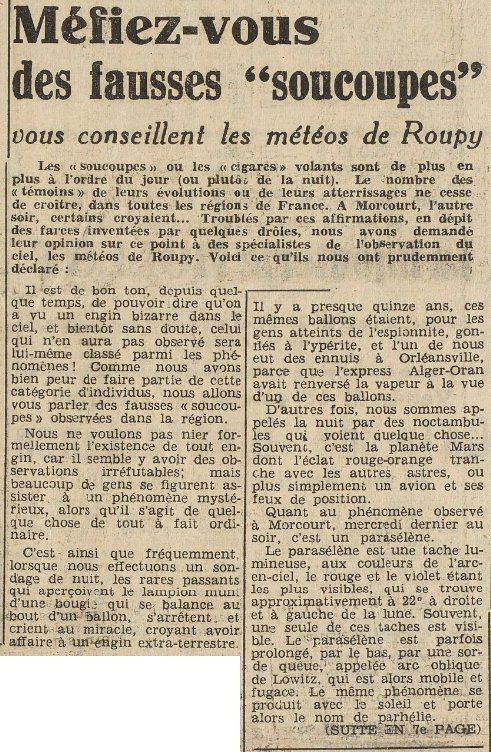The article below was published in the daily newspaper L'Aisne Nouvelle, France, page 1, on October 9, 1954.

|
"Saucers" or flying "cigars" are increasingly in the news (or rather, in the night). The number of "witnesses" to their movements or landings continues to grow across all regions of France. In Morcourt the other evening, some believed... Troubled by these claims - despite the hoaxes invented by a few pranksters - we asked for the opinion of sky-observation specialists, the meteorologists of Roupy. Here is what they cautiously told us:
It has become fashionable recently to say that one has seen a strange object in the sky, and soon, no doubt, those who haven't will themselves be considered phenomena! As we are afraid we might belong to that category, we will tell you about the fake "saucers" observed in the region.
We don't want to categorically deny the existence of every such craft, as some sightings seem irrefutable; but many people believe they are witnessing a mysterious phenomenon when in fact it's something entirely ordinary.
For example, when we conduct a night-time weather balloon launch, the rare passersby who spot the lantern with a candle swaying at the end of the balloon stop and shout in amazement, thinking they're seeing an extraterrestrial craft.
Nearly 15 years ago, those same balloons were, for people suffering from "spy fever," imagined to be filled with mustard gas, and one of us had trouble in Orléansville because the Algiers-Oran express train reversed course upon seeing one of them.
Other times, we're called in the middle of the night by night owls who see something... Often, it's the planet Mars, whose reddish-orange glow stands out from the other stars - or more simply, an airplane and its navigation lights.
As for the phenomenon observed in Morcourt last Wednesday evening, it was a paraselene.
A paraselene is a luminous spot with the colors of a rainbow - red and violet being the most visible - that appears roughly 22° to the right and left of the moon. Often, only one of these spots is visible. The paraselene is sometimes extended downward by a sort of tail, called a Lowitz arc, which is mobile and fleeting. The same phenomenon occurs with the sun and is then called a parhelion.
(CONTINUED ON PAGE 7)

|
(Continued from page 1)
This phenomenon is related to the halo - the large luminous circle often seen around the moon and the sun - and has the same cause. All these luminous phenomena are due to the decomposition of light emitted or reflected by the celestial body as it passes through a very high cloud layer called cirrostratus, which is made up of ice crystals. The solidified water acts like a prism, and depending on the shape and orientation of the crystals, the nature of the phenomena varies.
Uninformed observers only notice these phenomena at night, because during the day they are masked by the sun's brightness, even though they are actually clearer. The cloud layer that causes this light refraction is very thin - sometimes invisible - and the appearance of one of these phenomena helps meteorologists identify it.
We will add that these luminous phenomena are often early signs of rain, as the clouds that cause them almost always precede a weather disturbance.